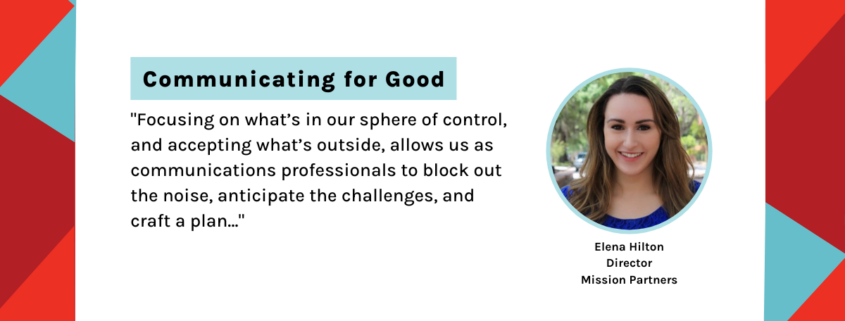Our Sphere of Control: How to Communicate Through (and Around) the Roadblocks
When was the last time you found yourself dwelling on something you can’t change? For me, it’s usually about a flight. I’m not an easygoing traveler. Leading up to each trip, I engage in my “rumination routine” where I obsess over potential worst-case scenarios in case of flight delays, missed connections, or bad weather, despite having already made detailed back-up plans. What if the plane makes an emergency landing in the wrong city? Remember when that happened that one time?
These panic spirals are equal parts exhausting and unhelpful. There’s no doubt that being an overly prepared person has helped me effectively guide clients through key moments, but it’s just as important to know where my mental energy can be best spent. Over the years, I’ve spent so much energy trying to control the uncontrollable rather than accepting that I’ve prepared enough to deal with hiccups as they occur.
At Mission Partners, we’ve counseled hundreds of organizations as they work to move their missions forward through communications. More often than not, the journey is fluid, nonlinear, and subject to countless external factors. It’s daunting—and truthfully, impossible—for an organization to bulldoze through every single roadblock that threatens a smooth campaign launch, event, or organizational shift.
Focusing on what’s in our sphere of control, and accepting what’s outside, allows us as communications professionals to block out the noise, anticipate the challenges, and craft a plan to skillfully maneuver through the barriers so that we can make a true impact. Communicators are usually known for juggling many balls at once—why not choose the ones that matter most?
On a macro level, there’s plenty that’s outside our sphere of control, whether it’s severe weather events, pandemics, or election results. But on a micro level, it’s also important to know that you can’t force another department to solidify their event plans, and you can’t always anticipate how the board will allocate next year’s budget. You can, however, influence, plan, and communicate accordingly.
I saw this approach up close while working alongside a budding coalition for the protection of local news during the early days of COVID-19, when every day was uncertain. As the group worked to influence elected officials to consider government funding for crucial local news outlets, the strategy and talking points ebbed and flowed as we heard reactions from Congress members. We discovered where the gaps were in understanding and adjusted our thoroughly researched talking points. We prepared materials to jump into the conversation when new bills were being drafted, and we organized strategically to build up our roster of spokespeople. The coalition was never in full control of what Congress members would do next, but we were always ready to react and steer the conversation.
By narrowing down what aspects of communication we can truly control, it frees us up to invest more deeply into the areas where we can actually make a difference. To allow yourself the time and energy for deeper, more meaningful work, consider the following:
- Start earlier than you think. Give yourself enough time to align with external departments and stakeholders so you can make your plans a reality, or pivot when you need to.
- Find the line between ambitious and realistic. Base your decisions off past success, lessons learned, and research, while still allowing your team some room for educated risks.
- Listen closely. We learn what potential scenarios to prepare for by staying tuned in to the landscape we’re working within. By asking the right questions, you can determine what a policymaker is looking for or understand why messages aren’t connecting with donors.
- Communicate along the way. For our external communications plans to go smoothly, we need frequent, open, and vulnerable discussions with our internal team members. Devoting time to openly talk with your team about the challenges at hand will help you manage to the outcome more easily.
Accepting your sphere of control doesn’t mean throwing your hands up and calling it a day. Rather, it requires a careful scan of the landscape to understand what might prevent you from getting the results you want and what you can do instead. It requires using the power of communications to influence the folks who can help you achieve your goals. And it requires diligent and thoughtful preparation so that you can easily pivot when needed, without spending too much time worrying about what can’t be changed.
Above all, take a deep breath, and focus on the power you have, not the power you don’t.





 Check out our new
Check out our new